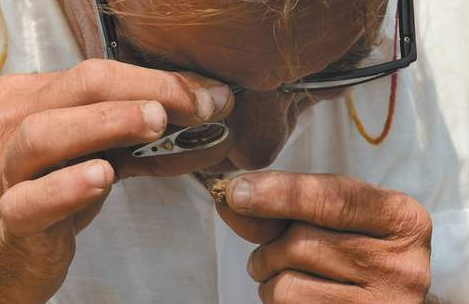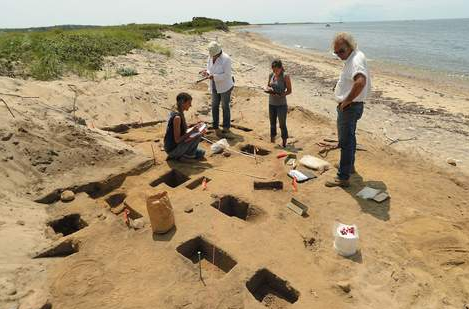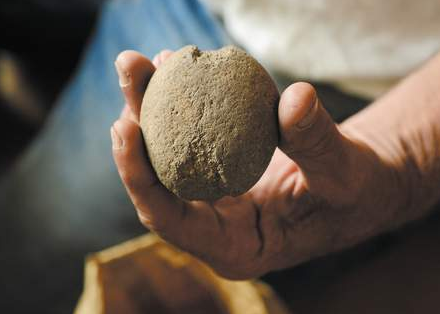Judy Benson
Source - http://www.theday.com/article/20140803/NWS01/308039954/-1/NWS
Archaeological dig on Block Island unearths evidence of Manissee tribe

Kevin McBride, professor of anthropology at the University of Connecticut and director of research at the Mashantucket Pequot Museum, uses a loop to examine what may be a piece of pottery, which archaeologists unearthed Wednesday at Block Island's Grace's Cove, site of possible Manissee tribe activity dating to approximately 1500. Dana Jensen/The Day
Block Island, R.I. - Each no bigger than a fingernail, the two brown shards easily could have been mistaken for insignificant bits of rock, hardly a fitting reward for a day's work.

Kevin McBride, far right, professor of anthropology at the University of Connecticut and director of research at the Mashantucket Pequot Museum, listens as archaeologists, from left, Amara Litten, Kathleen Boushee and Heather Manwaring describe the possible Manissee tribal artifacts they found Wednesday on Block Island's West Beach. Dana Jensen/The Day
But to Kevin McBride and his dozen-member archaeology crew combing the shores of this 11-square-mile summer playground, the find at Grace's Cove beach Wednesday was exactly what all the careful digging, scraping and sifting were about.
"I found the first one here," said Meg Lankowsky, one of the archaeologists working with McBride, pointing to a spot on a 3-foot strip between the dunes and the beach where she and two of her colleagues had spent the day cutting into the sandy soil.
McBride examined the tiny ragged shards, each with a lined pattern on one side, agreeing with Lankowsky that they probably are pieces of pottery left by the Manissee tribe that once inhabited the island. The pottery chips, along with stones fashioned into weights for fishing nets, and knives, spear points, scraping tools, sturgeon bones and dozens of other artifacts are being collected, recorded in ledgers and bagged for future identification and analysis, the stockpile growing in a back room in the island's historic Southeast Lighthouse.

Kevin McBride, professor of anthropology at the University of Connecticut and director of research at the Mashantucket Pequot Museum, holds a net sinker that was found at West Beach on Block Island by archaeologists at a site of possible Manissee tribe activity dating to approximately 1500. Dana Jensen/The Day
"We're trying to get a good understanding of Native American life and history out here," said McBride, professor of anthropology at the University of Connecticut and director of research at the Mashantucket Pequot Museum & Research Center. "Most of the sites we're finding are from the last 3,000 years."
McBride has been running archaeological digs here since 1983, but it wasn't until 2012, when Superstorm Sandy gouged out broad sections of these dunes, that his chance to lead this project - the most comprehensive archaeological study of Block Island that's ever been done, he said - came along. The state of Rhode Island decided to use about $500,000 of federal storm relief funds earmarked for assessments of cultural resources damaged by the storm to fund archaeological work along the state's shoreline and the Block Island coast. The Mashantucket Pequot Museum and McBride joined on as partners in the project, with the museum making its labs and experts available for analysis of the unearthed artifacts.
"We walked the entire island looking for sites eroding out of the bluffs," said McBride, as he drove his bright yellow 1975 Jeep along one of the island's bumpy dirt roads to a remote beach rarely visited by the thousands who populate the island on summer days. "Sandy did things to this island's coastline that no one's ever seen before, stripping away these dunes. The sites we're focusing on are at risk in the next storm. The artifacts we're finding will be lost if you don't pick them up."
Citizen archaeologists
The museum is offering the public a chance to work on this project alongside McBride and his crews for a day this summer. The groups are kept small, usually one family or one couple at a time taking the ferry over from New London to spend a day with McBride engaged in a very different style of playing in the sand from the kind all the kids and families on Block Island's public beaches usually enjoy.
"They love finding stuff," McBride said of the citizen archaeologists, "and they get a sense of the precise nature of archaeological work."
His initial survey of the coast turned up 160 archaeological sites, about one quarter of the island's shoreline, he said. That speaks to the long history of American Indian settlements on the island, he said, and to how highly productive the marine ecosystem was for sustaining these communities, with abundant supplies of saltwater and freshwater fish, shellfish, sea birds, porpoises and seals, and land for growing maize and squash.
After finding those 160 sites, the team focused on more detailed excavation of selected areas. At one of those, at West Beach, a three-woman crew of archaeologists have found evidence of a fishing camp probably used by the Manissees between 1400 and 1600, before Europeans began colonizing the island in the mid-1600s. They've found bones from sturgeon, caught from dugout canoes during the spring runs offshore, and stones reddened and cracked from use in a fire pit that probably was used to smoke the fish. The team also uncovered soil blackened from the rotted remains of a wooden post that probably once supported a wigwam or other structure, McBride said.
At another site, on Black Rock Point beach, a three-person team spent Wednesday digging 2-foot-square test pits on the bluffs above the beach where a site had been identified earlier. The purpose, McBride said, was to determine whether any artifacts similar to what was found at the beach could be found on higher ground, and to deduce how much erosion had taken place over the centuries. However, the work Wednesday turned up no clues to the past, so McBride would be redirecting them for the next day's excavation.
The project is likely to continue for another year, with the winter and fall months spent cataloguing and analyzing the artifacts found thus far before excavation resumes in the spring. A report on the work is due to the state of Rhode Island by September 2015, McBride said. But he's hoping to share what he finds with a much wider audience.
"I would like to produce some educational material for the Block Island Historical Society, and some exhibits, and get the schools involved," he said. "The community here has been very supportive of what we're doing, and we'd like to return something to them."
Block Island, he added, is an ideal environment for an archeologist, because the native inhabitants were a single group with a unique maritime culture distinct from their mainland cousins. He estimates that about 1,200 Manissees were living on the island at the time of the European contact.
"The great thing about Block Island is that it's self-contained. You know the resources that were available to the people," he said. "It's large enough to support people with a diversity of resources, but it's only one group, so you have a much better chance of figuring stuff out."